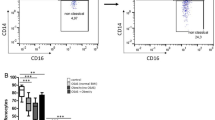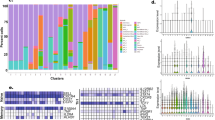Abstract
Background:
To characterize the distribution of both tonsillar and circulating CD4+T-lymphocyte subsets, and to explore their clinical relevance in nonobese children with obstructive sleep apnea syndrome (OSAS).
Methods:
A total of 53 children who underwent tonsillectomy for either OSAS (n = 25) or primary snoring (PS, n = 28) were prospectively enrolled. Nineteen healthy children without any symptoms were recruited as controls. We quantified the frequencies of CD4+T-lymphocyte subpopulations using flow cytometry, serum-related cytokines using enzyme-linked immunosorbent assay, and key transcription factors using quantitative polymerase chain reaction (qPCR).
Results:
Tonsillar distributions of CD4+T-lymphocyte subsets were comparable in the OSAS and PS subjects. The peripheral Th17/Treg ratio was positively correlated to severity as measured by apnea/hypopnea index (AHI), serum C-reactive protein and hypoxia-inducible factor-1α mRNA in the OSAS children (P < 0.05). And AHI was independently associated with the peripheral Th17/Treg ratio (P < 0.05). Furthermore, the response to surgery was associated with a significant reversal of the Th17/Treg imbalance and a concomitant relief of the proinflammatory profile in the OSAS subjects.
Conclusion:
Pediatric OSAS was associated with an altered Th17:Treg balance toward Th17 predominance. The changes in lymphocytic phenotypes that correlated with recurrent intermittent hypoxia in sleep apnea may contribute to the variance in systemic inflammation and downstream morbidities of pediatric OSAS.
Similar content being viewed by others
Log in or create a free account to read this content
Gain free access to this article, as well as selected content from this journal and more on nature.com
or
References
Marcus CL, Brooks LJ, Draper KA, et al.; American Academy of Pediatrics. Diagnosis and management of childhood obstructive sleep apnea syndrome. Pediatrics 2012;130:e714–55.
Ryan S, Taylor CT, McNicholas WT. Selective activation of inflammatory pathways by intermittent hypoxia in obstructive sleep apnea syndrome. Circulation 2005;112:2660–7.
Garvey JF, Taylor CT, McNicholas WT. Cardiovascular disease in obstructive sleep apnoea syndrome: the role of intermittent hypoxia and inflammation. Eur Respir J 2009;33:1195–205.
Liu H, Zhang T, Ye J, et al. Tumor-infiltrating lymphocytes predict response to chemotherapy in patients with advance non-small cell lung cancer. Cancer Immunol Immunother 2012;61:1849–56.
Cheng X, Yu X, Ding YJ, et al. The Th17/Treg imbalance in patients with acute coronary syndrome. Clin Immunol 2008;127:89–97.
Ye J, Liu H, Zhang G, et al. The treg/th17 imbalance in patients with obstructive sleep apnoea syndrome. Mediators Inflamm 2012;2012:815308.
Barbi J, Pardoll D, Pan F. Metabolic control of the Treg/Th17 axis. Immunol Rev 2013;252:52–77.
Verhulst SL, Aerts L, Jacobs S, et al. Sleep-disordered breathing, obesity, and airway inflammation in children and adolescents. Chest 2008;134:1169–75.
Dyugovskaya L, Lavie P, Lavie L. Lymphocyte activation as a possible measure of atherosclerotic risk in patients with sleep apnea. Ann N Y Acad Sci 2005;1051:340–50.
Zhang L, Li JM, Liu XG, et al. Elevated Th22 cells correlated with Th17 cells in patients with rheumatoid arthritis. J Clin Immunol 2011;31:606–14.
Zhang L, Li YG, Li YH, et al. Increased frequencies of Th22 cells as well as Th17 cells in the peripheral blood of patients with ankylosing spondylitis and rheumatoid arthritis. PLoS One 2012;7:e31000.
Truchetet ME, Brembilla NC, Montanari E, Allanore Y, Chizzolini C. Increased frequency of circulating Th22 in addition to Th17 and Th2 lymphocytes in systemic sclerosis: association with interstitial lung disease. Arthritis Res Ther 2011;13:R166.
Tan HL, Gozal D, Wang Y, et al. Alterations in circulating T-cell lymphocyte populations in children with obstructive sleep apnea. Sleep 2013;36:913–22.
Tan HL, Gozal D, Samiei A, et al. T regulatory lymphocytes and endothelial function in pediatric obstructive sleep apnea. PLoS One 2013;8:e69710.
Lages CS, Suffia I, Velilla PA, et al. Functional regulatory T cells accumulate in aged hosts and promote chronic infectious disease reactivation. J Immunol 2008;181:1835–48.
Bollinger T, Bollinger A, Naujoks J, Lange T, Solbach W. The influence of regulatory T cells and diurnal hormone rhythms on T helper cell activity. Immunology 2010;131:488–500.
Kim J, Bhattacharjee R, Khalyfa A, et al. DNA methylation in inflammatory genes among children with obstructive sleep apnea. Am J Respir Crit Care Med 2012;185:330–8.
Yuan G, Nanduri J, Bhasker CR, Semenza GL, Prabhakar NR. Ca2+/calmodulin kinase-dependent activation of hypoxia inducible factor 1 transcriptional activity in cells subjected to intermittent hypoxia. J Biol Chem 2005;280:4321–8.
Dang EV, Barbi J, Yang HY, et al. Control of T(H)17/T(reg) balance by hypoxia-inducible factor 1. Cell 2011;146:772–84.
Steiropoulos P, Kotsianidis I, Nena E, et al. Long-term effect of continuous positive airway pressure therapy on inflammation markers of patients with obstructive sleep apnea syndrome. Sleep 2009;32:537–43.
Gozal D, Kheirandish-Gozal L. Childhood obesity and sleep: relatives, partners, or both?–a critical perspective on the evidence. Ann N Y Acad Sci 2012;1264:135–41.
Kim J, Bhattacharjee R, Dayyat E, et al. Increased cellular proliferation and inflammatory cytokines in tonsils derived from children with obstructive sleep apnea. Pediatr Res 2009;66:423–8.
Kaditis AG, Ioannou MG, Chaidas K, et al. Cysteinyl leukotriene receptors are expressed by tonsillar T cells of children with obstructive sleep apnea. Chest 2008;134:324–31.
Toros SZ, Noşeri H, Ertugay CK, et al. Adenotonsillar hypertrophy: Does it correlate with obstructive symptoms in children? Int J Pediatr Otorhinolaryngol 2010;74:1316–9.
Granzotto EH, Aquino FV, Flores JA, Lubianca Neto JF. Tonsil size as a predictor of cardiac complications in children with sleep-disordered breathing. Laryngoscope 2010;120:1246–51.
Brodsky L. Modern assessment of tonsils and adenoids. Pediatr Clin North Am 1989;36:1551–69.
Ye J, Liu H, Zhang G, Huang Z, Huang P, Li Y. Postoperative respiratory complications of adenotonsillectomy for obstructive sleep apnea syndrome in older children: prevalence, risk factors, and impact on clinical outcome. J Otolaryngol Head Neck Surg 2009;38:49–58.
Ye J, Liu H, Li Y, Liu X, Zhu JM. Increased serum levels of C-reactive protein and matrix metalloproteinase-9 in obstructive sleep apnea syndrome. Chin Med J (Engl) 2007;120:1482–6.
Katz ES, Greene MG, Carson KA, et al. Night-to-night variability of polysomnography in children with suspected obstructive sleep apnea. J Pediatr 2002;140:589–94.
Jackman AR, Biggs SN, Walter LM, et al. Sleep disordered breathing in early childhood: quality of life for children and families. Sleep 2013;36:1639–46.
Author information
Authors and Affiliations
Corresponding author
Rights and permissions
About this article
Cite this article
Ye, J., Liu, H., Li, P. et al. CD4+T-lymphocyte subsets in nonobese children with obstructive sleep apnea syndrome. Pediatr Res 78, 165–173 (2015). https://doi.org/10.1038/pr.2015.76
Received:
Accepted:
Published:
Issue date:
DOI: https://doi.org/10.1038/pr.2015.76
This article is cited by
-
The dysbiosis gut microbiota induces the alternation of metabolism and imbalance of Th17/Treg in OSA patients
Archives of Microbiology (2022)



